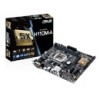Asus H110M-A User Guide - Page 18
Installing a DIMM
 |
View all Asus H110M-A manuals
Add to My Manuals
Save this manual to your list of manuals |
Page 18 highlights
• The default memory operation frequency is dependent on its Serial Presence Detect (SPD), which is the standard way of accessing information from a memory module. Under the default state, some memory modules for overclocking may operate at a lower frequency than the vendor-marked value. To operate at the vendor-marked or at a higher frequency, refer to section 2.5 Ai Tweaker menu for manual memory frequency adjustment. • Always install the DIMMs with the same CAS Latency. For an optimum compatibility, we recommend that you install memory modules of the same version or data code (D/C) from the same vendor. Check with the vendor to get the correct memory modules. • Visit the ASUS website at www.asus.com for the latest QVL. 1.4.3 1 Installing a DIMM 2 3 1-8 Chapter 1: Product introduction















